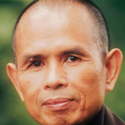
Walking Meditation
by Thich Nhat Hanh
Non-thinking is an art, and like any art, it requires patience and practice.
Reclaiming your attention and bringing your mind and body back together for even just ten breaths can be very difficult at first.
But with continued practice, you can reclaim your ability to be present and learn just to be.
Finding a few minutes to sit quietly is the easiest way to start training yourself to let go of your habitual thinking.
When you sit quietly, you can observe how your thoughts rush in, and you can practice not ruminating on them and instead let them just come and go as you focus on your breath and on the silence inside.
One woman I know decided she could never meditate because it just “ didn’t work."
So I asked her to take a walk with me.
I didn’t call it "walking meditation," but we walked slowly with awareness, enjoying the air and the feel of our feet on the ground.
When we came back, her eyes were bright and she seemed refreshed and clear.
If you can take just a few minutes for yourself to calm your body, your feelings, and your perceptions in this way, joy becomes possible.
Walking is a wonderful way to clear the mind without trying to clear the mind. You don’t say, "Now I am going to practice meditation!" or "Now I am going to not think!" You just walk, and while you’re focusing on the walking, joy and awareness come naturally.
In order to really enjoy the steps you make while walking, allow your mind to completely let go of any worry or plan. You don’t need to put in a lot of time and effort to prepare yourself to stop thinking. With one in-breath, you have already stopped. You breathe in, and you make a step.
In the beginning, you may need a little more time, maybe ten or 20 seconds of mindful breathing, before you can let your thinking go.
You can take one step with each in-breath and one step with each out breath. If your attention wanders, gently bring it back to your breathing.
Ten or 20 seconds is not a lot of time. One nerve impulse, one action potential, needs only a millisecond. If you want, you can give yourself even more time. In that short amount of time you can experience the bliss, the joy, the happiness of stopping.
During that time of stopping, your body is able to heal itself. Your mind also has the capacity to heal itself. There is nothing and no one to prevent you from continuing the joy you’ve produced with a second step, a second breath.
Your steps and your breath are always there to help you heal yourself.
Zen Master Thich Nhat Hanh is a global spiritual leader, poet and peace activist, revered around the world for his powerful teachings and bestselling writings on mindfulness and peace. He is the man Martin Luther King called “An Apostle of peace and nonviolence.” His key teaching is that, through mindfulness, we can learn to live happily in the present moment—the only way to truly develop peace, both in one’s self and in the world. Extract taken from Thich Nhat Hanh’s Silence